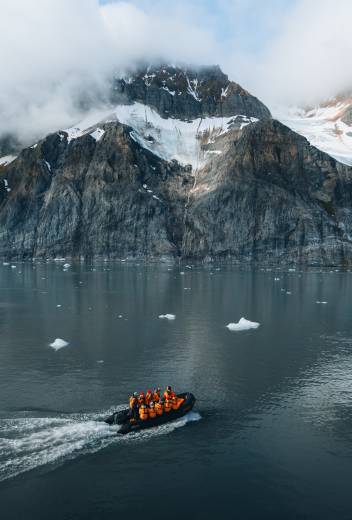A Day in the Life of a Polar Videographer
At Quark Expeditions, we pride ourselves on capturing the beauty of the Polar Regions through video storytelling. To share some insight into the video-creation process, we sat down with Quark Expeditions’ Video Content Specialist Dani Plumb, and Director and Cinematographer Hugo Perrin.
Introducing Quark Expeditions’ video creators
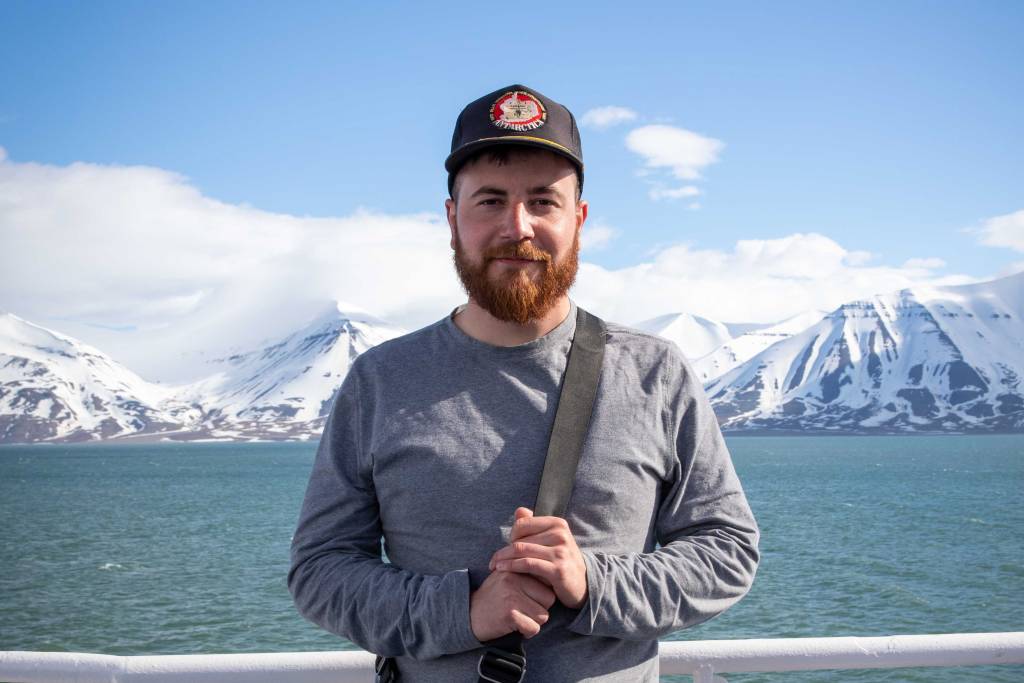
Director and cinematographer Hugo Perrin. (Photo: Dani Plumb )
Hugo Perrin, who was born and raised in France, has worked as a filmmaker in Canada since 2014. “It’s been a dream of mine to document the world since I was young,” says Hugo. “I remember spending hours and hours at my grandmother’s kitchen window watching and trying to capture birds with my camera. Decades later, my dream came true. I now film in the most remote parts of the world, places that are rich with wildlife and incredible landscapes. Creating videos can encompass everything I see and hear during a journey and they allow me to relive those moments.”
“I love telling real stories, and my many video collaborations in the Arctic and Antarctic with Quark Expeditions have provided me with life-changing encounters—often with inspiring people—and captivating stories to tell.”
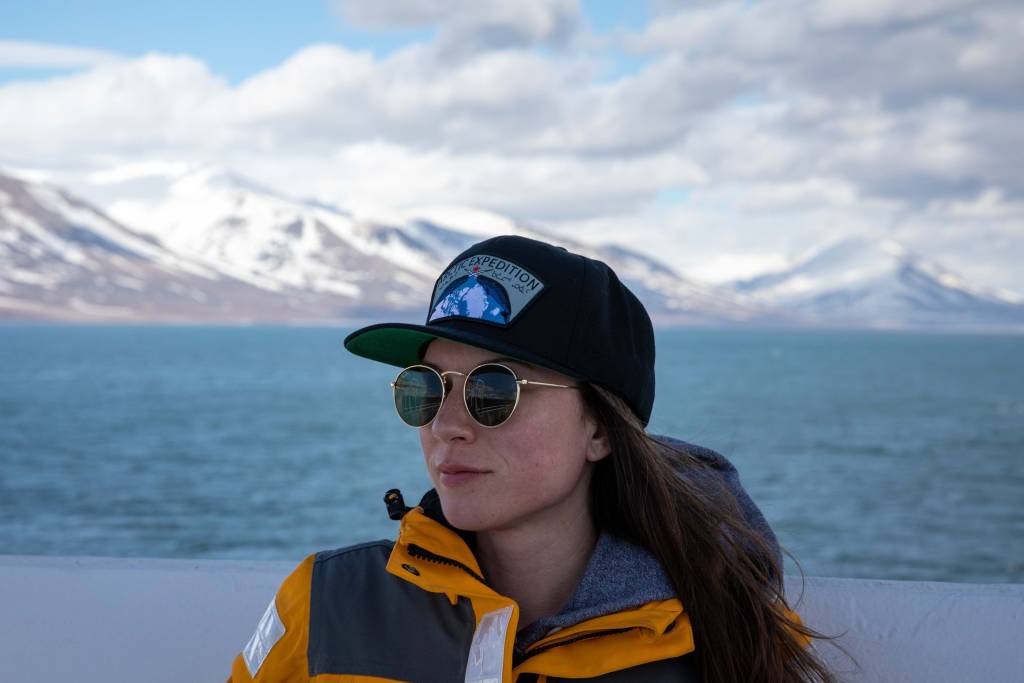
Video Content Specialist Dani Plumb on location in the Arctic. (Photo: Jared Plumb)
Dani Plumb has worked as the Video Content Specialist at Quark Expeditions since 2016. “Depending on the project, I might be a producer, videographer, video editor, content distributor, or a mix of these roles,” says Dani. “This gives me the opportunity to be creative in a lot of different ways, which is something I’ve always strived for. I’ve always been interested in different types of creative outlets, and because of that, it took me longer to really find my passion. When I started creating videos, everything just clicked. I’m always challenged to learn new things with video. I get to play with so many different elements — visuals, sound and story structure — to take people on a journey. And to do that in the Polar Regions means I have so much stunning raw material.”
Question: Hugo, how do you prepare for a video shoot in the Arctic or Antarctic? What gear do you bring?
Hugo: I work alone most of time, so I need to keep my gear light and compact. I film with a DSLR or mirrorless camera because they are light and portable yet still maintain image quality. I keep the rest of my gear compact as well, so everything can fit in a camera bag. I need all the gear accessible as we move through changing terrain and situations. In the remote wilderness you can’t run into a camera shop if you need something, so I carry doubles or a backup solution for most of my gear.
“During an expedition, I bring four different lenses. Most of them are zoom lenses because there are always surprises during expeditions. I’m always ready to shoot in every situation. In the Arctic, especially, the wildlife surprises us more. On the first day of a Spitsbergen expedition, we watched from the ship’s deck as a polar bear walked across the sea ice. My heart pumped fast enough to make my camera shake. And then a pod of belugas swam past the bear, while she continued to lumber along. It was such a rare and beautiful moment. Because these wildlife encounters pop up at any time, I’m always ready.
“I use natural light most of the time, but often it’s not easy to film in the Polar Regions because of the hard light. For interior interviews or shooting, I’ll use very powerful portable LED light though.
“For my rig, I often film hand-handle because it gives a more natural feel to the shot. Sometimes there are bumpy situations where a hand-handle shot cannot work, and in those situations I use gimbal as a stabilizer.”
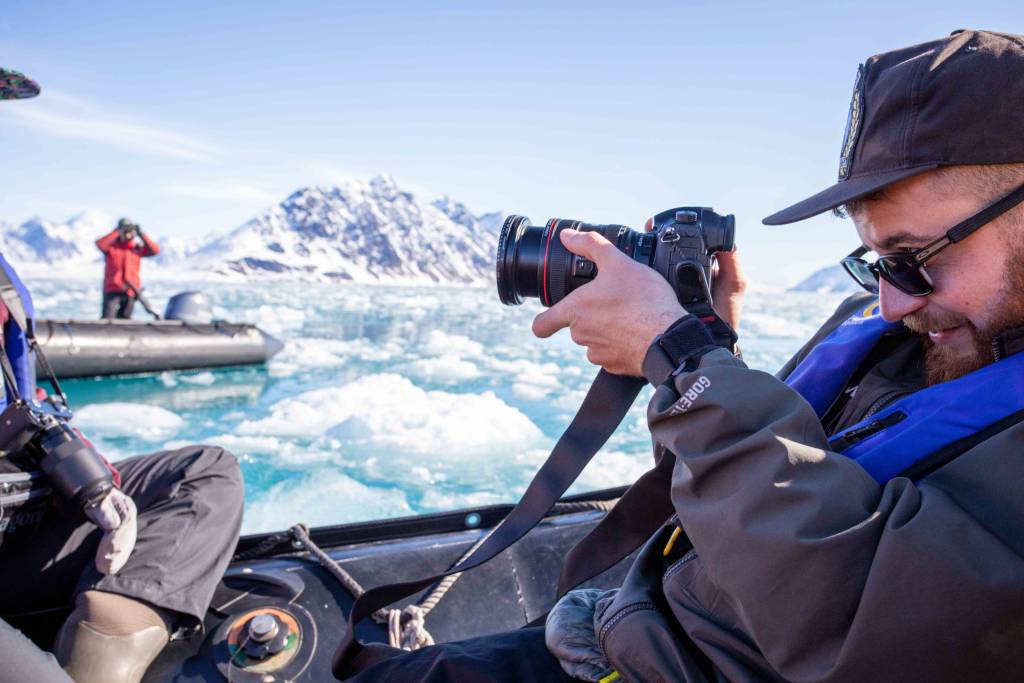
Director and cinematographer Hugo Perrin filming in Spitsbergen, in the Norwegian Arctic (Photo: Dani Plumb)
Q: Hugo, how do you manage to get such unscripted footage of wildlife?
Hugo: “The first thing necessary to capture awesome footage: you need to respect wildlife. At the beginning of every voyage, the Expedition Team will brief all of the guests on the regional regulations. In Antarctica, they’re set by the International Association of Antarctica Tour Operators (IAATO); and in the Arctic, by the Association of Arctic Expedition Cruise Operators (AECO). Both organizations promote safe and environmentally responsible travel to these regions.
“In addition, I believe that capturing great wildlife footage requires observation, timing, and patience—with speediness. You need to understand the behavior of each species in order to film at the best moment. You cannot direct wildlife like actors so you need to be ready to capture the good moments when they occur.“
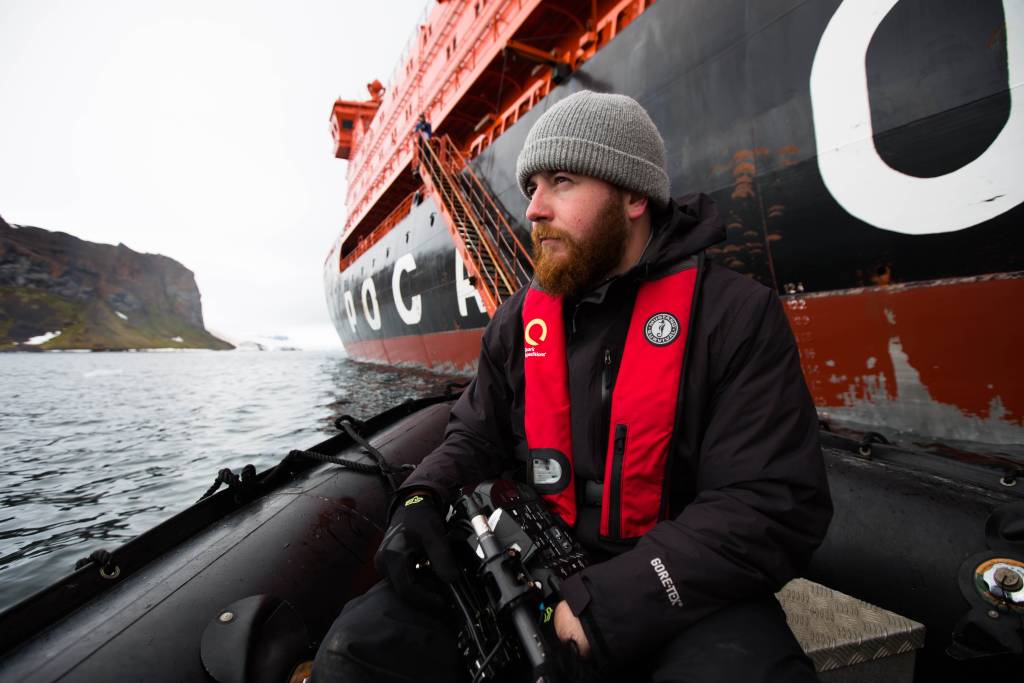
Capturing great wildlife videos requires patience and timing, among other traits, says Hugo Perrin. (Photo: Etienne Turmel)
“In 2018, I traveled to remote Snow Hill Island in Antarctica with Quark Expeditions to film the world-famous Emperor penguin colony. The sunlight in this region can be so powerful that overexposure is an issue. Observing a colony this massive made it difficult to capture the uniqueness of these penguins. I remember waiting hours for the perfect composition and for the perfect interaction between adults and the chicks. Observing the penguin colony on Snow Hill Island is a moment I’ll remember for the rest of my life.“

Emperor penguin colony at Snow Hill Island, Antarctica (Photo: Hugo Perrin)
Q: Hugo, what’s the biggest challenge when shooting video in the Polar Regions?
Hugo: “Every video project has its unique challenges. On a polar expedition, you need to be ready for anything. Expedition travel doesn’t necessarily have a set itinerary. We are guided by Mother Nature who dictates the weather and ice conditions. These factors don’t always make it easy production-wise, but I am very lucky to work with an exceptional Expedition Team who always help to find a solution for what we’re trying to capture.
“The Expedition Team is constantly on the lookout for wildlife from the Bridge and will let everyone know, let’s say, if a polar bear or whale has been spotted. This gives me time to concentrate on achieving my shot list, rather than spending time looking for wildlife. (However, I do love looking out for wildlife from the bridge when I can.)”
Q: Hugo, where do you shoot from most of the time?
Hugo: “I film from the ship, Zodiacs, and while I’m on land. It’s great to have all of these angles and perspectives for filming. For example, in a Zodiac, you can get low near the water or film wildlife with an underwater camera. On land, you can film from on top of a mountain. It’s a fantastic playground. Two of my favorite places to shoot from are the deck and bow of the ship. There are so many unique angles and possibilities as the vessel moves through the polar landscapes, and also when the ship slows down or stops when wildlife are curious about our presence.“
Q: Dani, I’ve seen some drone footage. Can you use drones anywhere you want in the Polar Regions?
Dani: The International Association of Antarctica Tour Operators (IAATO) and the Association of Arctic Expedition Cruise Operators (AECO) both strictly prohibit the recreational use of drones by guests. We at Quark Expeditions are only able to get permission to operate a drone when we’re filming footage for commercial and/or marketing purposes. The only other reason one might fly a drone in the Polar Regions is for scientific research purposes.
“We follow strict drone guidelines that are set by IAATO and AECO in order to ensure wildlife are not disturbed while flying. Different areas of the Arctic or Antarctic will have different rules for flying a drone. In order to gain permission for Hugo to fly, I’ll work with our Operations Team to ensure obtain all the required permits, and Hugo will sign off that he understands all the flying rules of the specific polar areas in question.”
Q: Hugo, what’s your most unforgettable video shoot moment?
Hugo: “When you’re filming during an expedition you don’t have the same luxuries that you might have on land, such as a recording studio. On a ship, you need to get more creative.
“When I was filming in Spitsbergen, we had planned to record a voiceover for the main video with Expedition Guide Annie Inglis (who has the voice of an angel). I wanted to find a good place to record the audio, but I wasn’t sure where – until I noticed a small toilet paper closet near my ship cabin.
“On most voyages, I am traveling and filming alone, but on this expedition I was accompanied by Video Content Specialist Dani Plumb and Brand Copywriter Doug O’Neill. With the team ready to record, the three of us plus Annie crowded into the small, cramped toilet paper closet all in the name of getting good audio quality! Of course, a staff person ended up walking in on four adults crammed into a tiny paper toilet closet. They were very shocked and confused. It’s a career moment I won’t forget.”

Audio recording session in the toilet paper closet during a Spitsbergen voyage—all in the name of producing a great video! (Photo: Hugo Perrin)
Q: Hugo, can you tell us what it’s like to get back to the editing studio after a trip to the Polar Regions?
Hugo: “In post-production, that’s where the magic happens. The first step is to cut everything down. On an expedition of 10 days, there are typically more than 15 hours of footage to review, including interviews. I’ll likely use 80% of the clips in the final video edits, but there is always some part where I shake the camera, or maybe the polar bear that I’ve filmed has its back facing the camera, so I cut best moments of every shot and classify them by order of quality.
“After that, I listen to all of the interviews I’ve recorded of staff and guests—people who are very passionate about the Polar Regions. Sometimes I’ll take an interview that’s over an hour and cut it down to 3 minutes or less. It can be really difficult to decide what is the best part! For example, when I created the video below with Expedition Guide Acacia Johnson, we talked for hours because she’s so passionate about what she does. Then it’s my job to select the key information from a lot of interesting content and distill that down to only a few minutes.
“Now it’s the time to assemble everything like a puzzle. It’s where I put everything together: the voice of the guest, the voice of the staff, the magical moments that I capture with music. I really like this part of the video-creation process.”
Q: Hugo, what gear do you recommend for guests who want to film in the Polar Regions?
Hugo: “Technology has evolved so much that everyone can create beautiful videos of their voyages. Here are some items that may help enhance your polar video:
- Underwater camera: There are many brands, but personally I use GoPro for underwater footage.
- Gimbal: To stabilize your camera or smartphone.
- Microphone: You can add a microphone to your camera or smartphone to capture sound. If you’re recording a voice, a lavalier microphone is good to use.
- Stabilized zoom lenses: Strongly recommended. Being able to zoom in on your subject and capture a variety of perspectives in a short amount of time will enable you to create a complete sequence to use in a video. Also, having the shot stabilized can save you from going home with an otherwise shaky and unusable shot. “
Q: Dani, do you have any recommendations for guests who want to film in the polar regions?
Dani: “In addition to the equipment Hugo mentioned, I’d also recommend bringing:
- Rain sleeves: To keep your camera dry
- Lens pens: To keep your lens clean,
- Dry sack: To keep your gear dry when you’re getting in and out the Zodiac.
All of these can be found in the on ship Polar Boutique.
“I’d also recommend extra camera batteries (which you can keep warm by putting inside your jacket), a couple of hard drives (for backup), polarized filters, and the widest lens you can get your hands on. Capturing the vastness of the Polar Regions will be difficult without a good wide angle lens.“
Q: Hugo, how has shooting videos in the Polar Regions changed your view of the Arctic and Antarctic?
Hugo: “As a teenager, I was fascinated by documentaries that captured the most remote places of the Earth. Watching wilderness footage made me feel like I was traveling in those incredible places. When I finally got the chance to visit the Polar Regions for the first time, it was a real shock. While film and video footage inspired me to travel to these destinations, I wasn’t fully prepared for the true beauty and soul of the polar regions.
“At the end of the day, despite all of my experience and the skills I’ve acquired shooting videos in the Polar Regions, I’m the first to admit that Mother Nature is the genius in this creative process. She is the guiding force. I simply listen, observe and try to capture nature at her best.”







